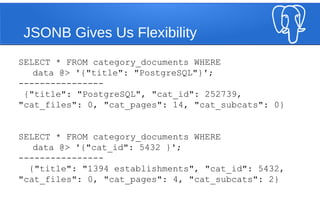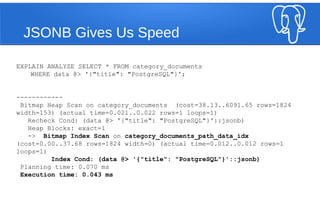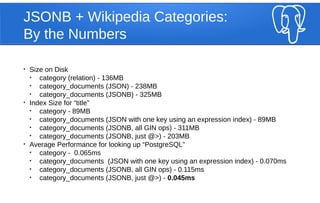Webscale PostgreSQL - JSONB and Horizontal Scaling Strategies
- 1. Web-Scale PostgreSQL Web-Scale PostgreSQL Jonathan S. Katz & Jim Mlodgenski NYC PostgreSQL User Group August 11, 2014
- 2. Who Are We? ● Jonathan S. Katz – CTO, VenueBook – jonathan@venuebook.com – @jkatz05 ● Jim Mlodgenski – CTO, OpenSCG – jimm@openscg.com – @jim_mlodgenski
- 3. Edgar Frank “Ted” Codd "A Relational Model of Data for Large Shared Data Banks"
- 4. The Relational Model ● All data => “n-ary relations” ● Relation => set of n-tuples ● Tuple => ordered set of attribute values ● Attribute Value => (attribute name, type name) ● Type => classification of the data (“domain”) ● Data is kept consistent via “constraints” ● Data is manipulated using “relational algebra”
- 5. And This Gives Us… ● Math! ● Normalization! ● SQL!
- 6. Relation Model ≠ SQL ● (Well yeah, SQL is derived from relational algebra, but still…) ● SQL deviates from the relational model with: – duplicate rows – anonymous columns (think functions, operations) – strict column order with storage – NULL
- 10. Now Back in the Real World… • Data is imperfect • Data is stored imperfectly • Data is sometimes transferred between different systems • And sometimes we just don’t want to go through the hassle of SQL
- 11. In Short There are many different ways to represent data
- 12. 1 => 7 "a" => "b" TRUE => ["car", "boat", "plane"] Key-Value Pairs (or a “hash”) (also Postgres supports this - see “hstore”)
- 13. Graph Database (sorry for the bad example)
- 14. XML (sorry) (and Postgres supports this) <?xml version=“1.0”?> <addresses> <address company_name=“Data Co.”> <street1>123 Fake St</street1> <street2>#24</street2> <city>New York</city> <state>NY</state> <zip>10001</zip> </address> <address company_name=“Graph Inc.”> <street1>157 Fake St</street1> <street2></street2> <city>New York</city> <state>NY</state> <zip>10001</zip> </address> </addresses>
- 15. JSON (which is why we’re here tonight, right?) [ { “company_name”: “Data Co.”, “street1”: “123 Fake St”, “street2”: “#24”, “city”: “New York”, “state”: “NY”, “zip”: “10001” }, { “company_name: “Graph Inc.”, “street1”: “157 Fake St”, “city”: “New York”, “state”: “NY”, “zip”: “10001” } ]
- 16. JSON and PostgreSQL ● Started in 2010 as a Google Summer of Code Project – https://wiki.postgresql.org/wiki/JSON_datatype_GSo C_2010 ● Goal: be similar to XML data type functionality in Postgres ● Be committed as an extension for PostgreSQL 9.1
- 17. What Happened? • Different proposals over how to finalize the implementation – binary vs. text • Core vs Extension • Discussions between “old” vs. “new” ways of packaging for extensions
- 18. Foreshadowing
- 19. Foreshadowing
- 20. PostgreSQL 9.2: JSON • JSON data type in core PostgreSQL • based on RFC 4627 • only “strictly” follows if your database encoding is UTF-8 • text-based format • checks for validity
- 21. PostgreSQL 9.2: JSON SELECT '[{"PUG": "NYC"}]'::json; json ------------------ [{"PUG": "NYC"}] SELECT '[{"PUG": "NYC"]'::json; ERROR: invalid input syntax for type json at character 8 DETAIL: Expected "," or "}", but found "]". CONTEXT: JSON data, line 1: [{"PUG": "NYC"]
- 22. PostgreSQL 9.2: JSON ● array_to_json SELECT array_to_json(ARRAY[1,2,3]); array_to_json --------------- [1,2,3]
- 23. PostgreSQL 9.2: JSON ● row_to_json SELECT row_to_json(category)FROM category; row_to_json ------------ {"cat_id":652,"cat_pages":35,"cat_subcats":17,"cat_files ":0,"title":"Continents"} (1 row)
- 24. PostgreSQL 9.2: JSON In summary, within core PostgreSQL, it was a starting point
- 25. PostgreSQL 9.3: JSON Ups its Game • Added operators and functions to read / prepare JSON • Added casts from hstore to JSON
- 26. PostgreSQL 9.3: JSON Operator Description Example -> return JSON array element OR JSON object field '[1,2,3]'::json -> 0; '{"a": 1, "b": 2, "c": 3}'::json -> 'b'; ->> return JSON array element OR JSON object field AS text ['1,2,3]'::json ->> 0; '{"a": 1, "b": 2, "c": 3}'::json ->> 'b'; #> return JSON object using path '{"a": 1, "b": 2, "c": [1,2,3]}'::json #> '{c, 0}'; #>> return JSON object using path AS text '{"a": 1, "b": 2, "c": [1,2,3]}'::json #> '{c, 0}';
- 27. Operator Gotchas SELECT * FROM category_documents WHERE data->'title' = 'PostgreSQL'; ERROR: operator does not exist: json = unknown LINE 1: ...ECT * FROM category_documents WHERE data- >'title' = 'Postgre... ^HINT: No operator matches the given name and argument type(s). You might need to add explicit type casts.
- 28. Operator Gotchas SELECT * FROM category_documents WHERE data->>'title' = 'PostgreSQL'; ----------------------- {"cat_id":252739,"cat_pages":14,"cat_subcats":0, "cat_files":0,"title":"PostgreSQL"} (1 row)
- 29. For the Upcoming Examples • Wikipedia English category titles – all 1,823,644 that I downloaded • Relation looks something like: Column | Type | Modifiers -------------+---------+-------------------- cat_id | integer | not null cat_pages | integer | not null default 0 cat_subcats | integer | not null default 0 cat_files | integer | not null default 0 title | text |
- 30. Performance? EXPLAIN ANALYZE SELECT * FROM category_documents WHERE data->>'title' = 'PostgreSQL'; --------------------- Seq Scan on category_documents (cost=0.00..57894.18 rows=9160 width=32) (actual time=360.083..2712.094 rows=1 loops=1) Filter: ((data ->> 'title'::text) = 'PostgreSQL'::text) Rows Removed by Filter: 1823643 Total runtime: 2712.127 ms
- 31. Performance? CREATE INDEX category_documents_idx ON category_documents (data); ERROR: data type json has no default operator class for access method "btree" HINT: You must specify an operator class for the index or define a default operator class for the data type.
- 32. Let’s Be Clever • json_extract_path, json_extract_path_text – LIKE (#>, #>>) but with list of args SELECT json_extract_path( '{"a": 1, "b": 2, "c": [1,2,3]}’::json, 'c', ‘0’); -------- 1
- 33. Performance Revisited CREATE INDEX category_documents_data_idx ON category_documents (json_extract_path_text(data, ‘title')); EXPLAIN ANALYZE SELECT * FROM category_documents WHERE json_extract_path_text(data, 'title') = 'PostgreSQL'; -------------------- Bitmap Heap Scan on category_documents (cost=303.09..20011.96 rows=9118 width=32) (actual time=0.090..0.091 rows=1 loops=1) Recheck Cond: (json_extract_path_text(data, VARIADIC '{title}'::text[]) = 'PostgreSQL'::text) -> Bitmap Index Scan on category_documents_data_idx (cost=0.00..300.81 rows=9118 width=0) (actual time=0.086..0.086 rows=1 loops=1) Index Cond: (json_extract_path_text(data, VARIADIC '{title}'::text[]) = 'PostgreSQL'::text) Total runtime: 0.105 ms
- 34. The Relation vs JSON • Size on Disk • category (relation) - 136MB • category_documents (JSON) - 238MB • Index Size for “title” • category - 89MB • category_documents - 89MB • Average Performance for looking up “PostgreSQL” • category - 0.065ms • category_documents - 0.070ms
- 35. JSON => SET • to_json • json_each, json_each_text SELECT * FROM json_each('{"a": 1, "b": [2,3,4], "c": "wow"}'::json); key | value -----+--------- a | 1 b | [2,3,4] c | "wow"
- 36. JSON Keys • json_object_keys SELECT * FROM json_object_keys( '{"a": 1, "b": [2,3,4], "c": { "e": "wow" }}’::json ); -------- a b c
- 37. Populating JSON Records • json_populate_record CREATE TABLE stuff (a int, b text, c int[]); SELECT * FROM json_populate_record( NULL::stuff, '{"a": 1, "b": “wow"}' ); a | b | c ---+-----+--- 1 | wow | SELECT * FROM json_populate_record( NULL::stuff, '{"a": 1, "b": "wow", "c": [4,5,6]}’ ); ERROR: cannot call json_populate_record on a nested object
- 38. Populating JSON Records ● json_populate_recordset SELECT * FROM json_populate_recordset(NULL::stuff, ‘[ {"a": 1, "b": "wow"}, {"a": 2, "b": "cool"} ]'); a | b | c ---+------+--- 1 | wow | 2 | cool |
- 39. JSON Aggregates • (this is pretty cool) • json_agg SELECT b, json_agg(stuff) FROM stuff GROUP BY b; b | json_agg ------+---------------------------------- neat | [{"a":4,"b":"neat","c":[4,5,6]}] wow | [{"a":1,"b":"wow","c":[1,2,3]}, + | {"a":3,"b":"wow","c":[7,8,9]}] cool | [{"a":2,"b":"cool","c":[4,5,6]}]
- 40. hstore gets in the game • hstore_to_json • converts hstore to json, treating all values as strings • hstore_to_json_loose • converts hstore to json, but also tries to distinguish between data types and “convert” them to proper JSON representations SELECT hstore_to_json_loose(‘"a key"=>1, b=>t, c=>null, d=>12345, e=>012345, f=>1.234, g=>2.345e+4'); ---------------- {"b": true, "c": null, "d": 12345, "e": "012345", "f": 1.234, "g": 2.345e+4, "a key": 1}
- 41. Next Steps? • In PostgreSQL 9.3, JSON became much more useful, but… • Difficult to search within JSON • Difficult to build new JSON objects
- 42. “Nested hstore” • Proposed at PGCon 2013 by Oleg Bartunov and Teodor Sigaev • Hierarchical key-value storage system that supports arrays too and stored in binary format • Takes advantage of GIN indexing mechanism in PostgreSQL • “Generalized Inverted Index” • Built to search within composite objects • Arrays, fulltext search, hstore • …JSON?
- 43. How JSONB Came to Be • JSON is the “lingua franca per trasmissione la data nella web” • The PostgreSQL JSON type was in a text format and preserved text exactly as input • e.g. duplicate keys are preserved • Create a new data type that merges the nested Hstore work to create a JSON type stored in a binary format: JSONB
- 44. JSONB ≠ BSON BSON is a data type created by MongoDB as a “superset of JSON” JSONB lives in PostgreSQL and is just JSON that is stored in a binary format on disk
- 45. JSONB Gives Us More Operators • a @> b - is b contained within a? • { "a": 1, "b": 2 } @> { "a": 1} -- TRUE • a <@ b - is a contained within b? • { "a": 1 } <@ { "a": 1, "b": 2 } -- TRUE • a ? b - does the key “b” exist in JSONB a? • { "a": 1, "b": 2 } ? 'a' -- TRUE • a ?| b - does the array of keys in “b” exist in JSONB a? • { "a": 1, "b": 2 } ?| ARRAY['b', 'c'] -- TRUE • a ?& b - does the array of keys in "b" exist in JSONB a? • { "a": 1, "b": 2 } ?& ARRAY['a', 'b'] -- TRUE
- 46. JSONB Gives Us Flexibility SELECT * FROM category_documents WHERE data @> '{"title": "PostgreSQL"}'; ---------------- {"title": "PostgreSQL", "cat_id": 252739, "cat_files": 0, "cat_pages": 14, "cat_subcats": 0} SELECT * FROM category_documents WHERE data @> '{"cat_id": 5432 }'; ---------------- {"title": "1394 establishments", "cat_id": 5432, "cat_files": 0, "cat_pages": 4, "cat_subcats": 2}
- 47. JSONB Gives us GIN • Recall - GIN indexes are used to "look inside" objects • JSONB has two flavors of GIN: • Standard - supports @>, ?, ?|, ?& CREATE INDEX category_documents_data_idx USING gin(data); • "Path Ops" - supports only @> CREATE INDEX category_documents_path_data_idx USING gin(data jsonb_path_ops);
- 48. JSONB Gives Us Speed EXPLAIN ANALYZE SELECT * FROM category_documents WHERE data @> '{"title": "PostgreSQL"}'; ------------ Bitmap Heap Scan on category_documents (cost=38.13..6091.65 rows=1824 width=153) (actual time=0.021..0.022 rows=1 loops=1) Recheck Cond: (data @> '{"title": "PostgreSQL"}'::jsonb) Heap Blocks: exact=1 -> Bitmap Index Scan on category_documents_path_data_idx (cost=0.00..37.68 rows=1824 width=0) (actual time=0.012..0.012 rows=1 loops=1) Index Cond: (data @> '{"title": "PostgreSQL"}'::jsonb) Planning time: 0.070 ms Execution time: 0.043 ms
- 49. JSONB + Wikipedia Categories: By the Numbers • Size on Disk • category (relation) - 136MB • category_documents (JSON) - 238MB • category_documents (JSONB) - 325MB • Index Size for “title” • category - 89MB • category_documents (JSON with one key using an expression index) - 89MB • category_documents (JSONB, all GIN ops) - 311MB • category_documents (JSONB, just @>) - 203MB • Average Performance for looking up “PostgreSQL” • category - 0.065ms • category_documents (JSON with one key using an expression index) - 0.070ms • category_documents (JSONB, all GIN ops) - 0.115ms • category_documents (JSONB, just @>) - 0.045ms
- 50. JSONB Gives Us WTF: A Note On Operator Indexability EXPLAIN ANALYZE SELECT * FROM documents WHERE data @> ’{ "f1": 10 }’; QUERY PLAN ----------- Bitmap Heap Scan on documents (cost=27.75..3082.65 rows=1000 width=66) (actual time=0.029..0. rows=1 loops=1) Recheck Cond: (data @> ’{"f1": 10}’::jsonb) Heap Blocks: exact=1 -> Bitmap Index Scan on documents_data_gin_idx (cost=0.00..27.50 rows=1000 width=0) (actual time=0.014..0.014 rows=1 loops=1) Index Cond: (data @> ’{"f1": 10}’::jsonb) Execution time: 0.084 ms EXPLAIN ANALYZE SELECT * FROM documents WHERE ’{ "f1": 10 }’ <@ data; QUERY PLAN ----------- Seq Scan on documents (cost=0.00..24846.00 rows=1000 width=66) (actual time=0.015..245.924 ro Filter: (’{"f1": 10}’::jsonb <@ data) Rows Removed by Filter: 999999 Execution time: 245.947 ms
- 51. JSON ≠ Schema-less Some agreements must be made about the document The document must be validated somewhere Ensure that all of your code no matter who writes it conforms to a basic document structure
- 52. Enter PL/V8 ● Write your database functions in Javascript ● Validate your JSON inside of the database ● http://pgxn.org/dist/plv8/doc/plv8.html CREATE EXTENSION plv8;
- 53. Create A Validation Function CREATE OR REPLACE FUNCTION has_valid_keys(doc json) RETURNS boolean AS $$ if (!doc.hasOwnProperty('data')) return false; if (!doc.hasOwnProperty('meta')) return false; return true; $$ LANGUAGE plv8 IMMUTABLE;
- 54. Add A Constraint ALTER TABLE collection ADD CONSTRAINT collection_key_chk CHECK (has_valid_keys(doc::json)); scale=# INSERT INTO collection (doc) VALUES ('{"name": "postgresql"}'); ERROR: new row for relation "collection" violates check constraint "collection_key_chk" DETAIL: Failing row contains (ea438788-b2a0-4ba3-b27d- a58726b8a210, {"name": "postgresql"}).
- 55. Schema-Less ≠ Web-Scale Web-Scale needs to run on commodity hardware or the cloud Web-Scale needs horizontal scalability Web-Scale needs no single point of failure
- 56. Enter PL/Proxy ● Developed by Skype ● Allows for scalability and parallelization ● http://pgfoundry.org/projects/plproxy/ ● Used by many large organizations around the world
- 57. PL/Proxy
- 58. Setting Up A Proxy Server CREATE EXTENSION plproxy; CREATE SERVER datacluster FOREIGN DATA WRAPPER plproxy OPTIONS (connection_lifetime '1800', p0 'dbname=data1 host=localhost', p1 'dbname=data2 host=localhost' ); CREATE USER MAPPING FOR PUBLIC SERVER datacluster;
- 59. Create a “Get” Function CREATE OR REPLACE FUNCTION get_doc(i_id uuid) RETURNS SETOF jsonb AS $$ CLUSTER 'datacluster'; RUN ON hashtext(i_id::text) ; SELECT doc FROM collection WHERE id = i_id; $$ LANGUAGE plproxy;
- 60. Create a “Put” Function CREATE OR REPLACE FUNCTION put_doc( i_doc jsonb, i_id uuid DEFAULT uuid_generate_v4()) RETURNS uuid AS $$ CLUSTER 'datacluster'; RUN ON hashtext(i_id::text); $$ LANGUAGE plproxy;
- 61. Need a “Put” Function on the Shard CREATE OR REPLACE FUNCTION put_doc(i_doc jsonb, i_id uuid) RETURNS uuid AS $$ INSERT INTO collection (id, doc) VALUES ($2,$1); SELECT $2; $$ LANGUAGE SQL;
- 62. Parallelize A Query CREATE OR REPLACE FUNCTION get_doc_by_id (v_id varchar) RETURNS SETOF jsonb AS $$ CLUSTER 'datacluster'; RUN ON ALL; SELECT doc FROM collection WHERE doc @> CAST('{"id" : "' || v_id || '"}' AS jsonb); $$ LANGUAGE plproxy;
- 65. Who is running PostgreSQL?
- 66. Questions?


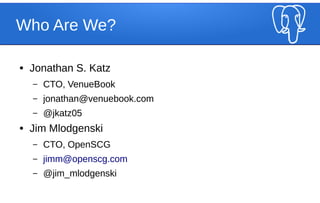
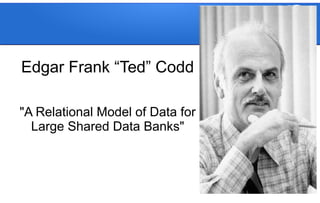






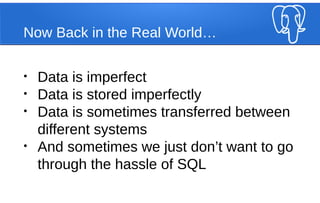

![1 => 7
"a" => "b"
TRUE => ["car", "boat", "plane"]
Key-Value Pairs
(or a “hash”)
(also Postgres supports this - see “hstore”)](https://image.slidesharecdn.com/postgresqlwebscale-140812090723-phpapp02/85/Webscale-PostgreSQL-JSONB-and-Horizontal-Scaling-Strategies-12-320.jpg)

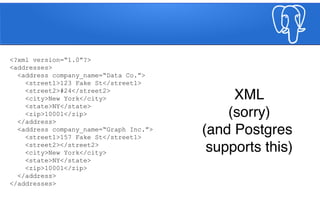
![JSON
(which is why we’re
here tonight, right?)
[
{
“company_name”: “Data Co.”,
“street1”: “123 Fake St”,
“street2”: “#24”,
“city”: “New York”,
“state”: “NY”,
“zip”: “10001”
},
{
“company_name: “Graph Inc.”,
“street1”: “157 Fake St”,
“city”: “New York”,
“state”: “NY”,
“zip”: “10001”
}
]](https://image.slidesharecdn.com/postgresqlwebscale-140812090723-phpapp02/85/Webscale-PostgreSQL-JSONB-and-Horizontal-Scaling-Strategies-15-320.jpg)





![PostgreSQL 9.2: JSON
SELECT '[{"PUG": "NYC"}]'::json;
json
------------------
[{"PUG": "NYC"}]
SELECT '[{"PUG": "NYC"]'::json;
ERROR: invalid input syntax for type json at character 8
DETAIL: Expected "," or "}", but found "]".
CONTEXT: JSON data, line 1: [{"PUG": "NYC"]](https://image.slidesharecdn.com/postgresqlwebscale-140812090723-phpapp02/85/Webscale-PostgreSQL-JSONB-and-Horizontal-Scaling-Strategies-21-320.jpg)
![PostgreSQL 9.2: JSON
●
array_to_json
SELECT array_to_json(ARRAY[1,2,3]);
array_to_json
---------------
[1,2,3]](https://image.slidesharecdn.com/postgresqlwebscale-140812090723-phpapp02/85/Webscale-PostgreSQL-JSONB-and-Horizontal-Scaling-Strategies-22-320.jpg)


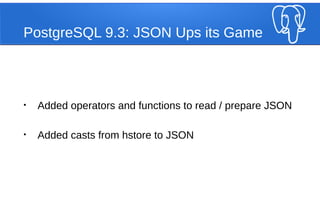
![PostgreSQL 9.3: JSON
Operator Description Example
-> return JSON array element OR
JSON object field
'[1,2,3]'::json -> 0;
'{"a": 1, "b": 2, "c": 3}'::json -> 'b';
->> return JSON array element OR
JSON object field AS text
['1,2,3]'::json ->> 0;
'{"a": 1, "b": 2, "c": 3}'::json ->> 'b';
#> return JSON object using path '{"a": 1, "b": 2, "c": [1,2,3]}'::json #> '{c, 0}';
#>> return JSON object using path AS
text
'{"a": 1, "b": 2, "c": [1,2,3]}'::json #> '{c, 0}';](https://image.slidesharecdn.com/postgresqlwebscale-140812090723-phpapp02/85/Webscale-PostgreSQL-JSONB-and-Horizontal-Scaling-Strategies-26-320.jpg)

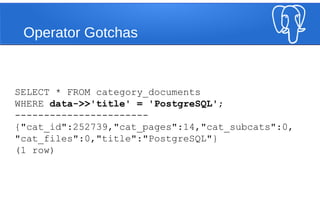



![Let’s Be Clever
• json_extract_path, json_extract_path_text
– LIKE (#>, #>>) but with list of args
SELECT json_extract_path(
'{"a": 1, "b": 2, "c": [1,2,3]}’::json,
'c', ‘0’);
--------
1](https://image.slidesharecdn.com/postgresqlwebscale-140812090723-phpapp02/85/Webscale-PostgreSQL-JSONB-and-Horizontal-Scaling-Strategies-32-320.jpg)
![Performance Revisited
CREATE INDEX category_documents_data_idx
ON category_documents
(json_extract_path_text(data, ‘title'));
EXPLAIN ANALYZE
SELECT * FROM category_documents
WHERE json_extract_path_text(data, 'title') = 'PostgreSQL';
--------------------
Bitmap Heap Scan on category_documents (cost=303.09..20011.96 rows=9118
width=32) (actual time=0.090..0.091 rows=1 loops=1)
Recheck Cond: (json_extract_path_text(data, VARIADIC '{title}'::text[]) =
'PostgreSQL'::text)
-> Bitmap Index Scan on category_documents_data_idx (cost=0.00..300.81
rows=9118 width=0) (actual time=0.086..0.086 rows=1 loops=1)
Index Cond: (json_extract_path_text(data, VARIADIC '{title}'::text[])
= 'PostgreSQL'::text)
Total runtime: 0.105 ms](https://image.slidesharecdn.com/postgresqlwebscale-140812090723-phpapp02/85/Webscale-PostgreSQL-JSONB-and-Horizontal-Scaling-Strategies-33-320.jpg)

![JSON => SET
• to_json
• json_each, json_each_text
SELECT * FROM
json_each('{"a": 1, "b": [2,3,4], "c":
"wow"}'::json);
key | value
-----+---------
a | 1
b | [2,3,4]
c | "wow"](https://image.slidesharecdn.com/postgresqlwebscale-140812090723-phpapp02/85/Webscale-PostgreSQL-JSONB-and-Horizontal-Scaling-Strategies-35-320.jpg)
![JSON Keys
• json_object_keys
SELECT * FROM json_object_keys(
'{"a": 1, "b": [2,3,4], "c": { "e":
"wow" }}’::json
);
--------
a
b
c](https://image.slidesharecdn.com/postgresqlwebscale-140812090723-phpapp02/85/Webscale-PostgreSQL-JSONB-and-Horizontal-Scaling-Strategies-36-320.jpg)
![Populating JSON Records
• json_populate_record
CREATE TABLE stuff (a int, b text, c int[]);
SELECT *
FROM json_populate_record(
NULL::stuff, '{"a": 1, "b": “wow"}'
);
a | b | c
---+-----+---
1 | wow |
SELECT *
FROM json_populate_record(
NULL::stuff, '{"a": 1, "b": "wow", "c": [4,5,6]}’
);
ERROR: cannot call json_populate_record on a nested object](https://image.slidesharecdn.com/postgresqlwebscale-140812090723-phpapp02/85/Webscale-PostgreSQL-JSONB-and-Horizontal-Scaling-Strategies-37-320.jpg)
![Populating JSON Records
●
json_populate_recordset
SELECT *
FROM json_populate_recordset(NULL::stuff, ‘[
{"a": 1, "b": "wow"},
{"a": 2, "b": "cool"}
]');
a | b | c
---+------+---
1 | wow |
2 | cool |](https://image.slidesharecdn.com/postgresqlwebscale-140812090723-phpapp02/85/Webscale-PostgreSQL-JSONB-and-Horizontal-Scaling-Strategies-38-320.jpg)
![JSON Aggregates
• (this is pretty cool)
• json_agg
SELECT b, json_agg(stuff)
FROM stuff
GROUP BY b;
b | json_agg
------+----------------------------------
neat | [{"a":4,"b":"neat","c":[4,5,6]}]
wow | [{"a":1,"b":"wow","c":[1,2,3]}, +
| {"a":3,"b":"wow","c":[7,8,9]}]
cool | [{"a":2,"b":"cool","c":[4,5,6]}]](https://image.slidesharecdn.com/postgresqlwebscale-140812090723-phpapp02/85/Webscale-PostgreSQL-JSONB-and-Horizontal-Scaling-Strategies-39-320.jpg)




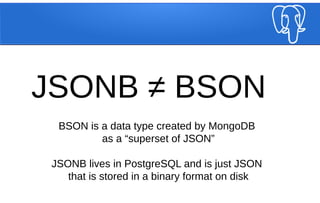
![JSONB Gives Us More Operators
• a @> b - is b contained within a?
• { "a": 1, "b": 2 } @> { "a": 1} -- TRUE
• a <@ b - is a contained within b?
• { "a": 1 } <@ { "a": 1, "b": 2 } -- TRUE
• a ? b - does the key “b” exist in JSONB a?
• { "a": 1, "b": 2 } ? 'a' -- TRUE
• a ?| b - does the array of keys in “b” exist in JSONB a?
• { "a": 1, "b": 2 } ?| ARRAY['b', 'c'] -- TRUE
• a ?& b - does the array of keys in "b" exist in JSONB a?
• { "a": 1, "b": 2 } ?& ARRAY['a', 'b'] -- TRUE](https://image.slidesharecdn.com/postgresqlwebscale-140812090723-phpapp02/85/Webscale-PostgreSQL-JSONB-and-Horizontal-Scaling-Strategies-45-320.jpg)
